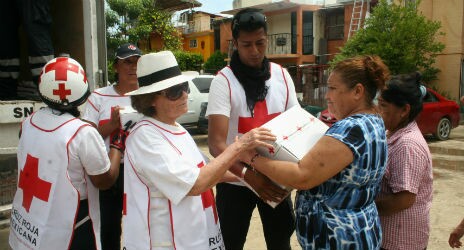
In June 2012, Mexico adopted a new General Civil Protection Act. The Act establishes the foundations for coordination between the three levels of government in the field of civil protection. It clarifies the roles and responsibilities of actors involved in the matter and it provides a comprehensive framework for disaster risk management, the National System of Civil Protection (SINAPROC). Anne Lice Hernández Alba, Relief Coordinator and Inter-institutional Focal Point of the Mexican Civil Protection Department, explains, “SINAPROC’s objective is to protect individuals, society and the environment from potential risks and to address natural or man-made vulnerabilities in the short, medium and long term, through the comprehensive management of risks and the promotion of adaptation capability, relief and rehabilitation.”
The updated Act added several novelties to the 2000 version. It created the National Committee for Emergencies, a mechanism for operational coordination in emergency situations and disasters. The National Committee has the mandate to analyse an emergency, evaluate its impact and make the necessary recommendations to protect the population; determine the urgent measures to be put in place; provide material and financial means for aid, recuperation and reconstruction operations; monitor the relief operations; and issue communiqués to inform media and the general public.
The Act also requires the relevant authorities to establish rules and guidelines for the appeal, reception, administration, control and distribution of donations in the event of a disaster. Individuals or corporations who want to collaborate with the reception of in-kind donations must obtain the approval of the State Civil Protection Units. These provisions ensure proper use of donations. Mexico is now developing implementing regulations for the General Civil Protection Act. The regulations will include a section on international donations. International disaster assistance through donations would therefore be regulated in Mexico thought the Act, the regulation, the guidelines, and other sectoral laws as needed.
The Act, and the section on donations in particular, was influenced by an analysis of Mexico’s legal framework based on the list of questions of the Regional Legal Compendium. The Compendium was developed through the Regional Meetings on Enhancing International Humanitarian Partnerships with the support of the IFRC and uses the IDRL Guidelines as benchmark and reference. Recalling her experience in coordinating Mexico’s chapter in the Compendium, Anne Lice Hernández Alba explains, “it allowed us to see gaps in our laws and procedures, identify best practices that have not yet been institutionalized yet, and to plan improvements. It created an excellent opportunity for us to take a stand on strengthening our approach in case an emergency in Mexico or abroad.”
In November 2012, Mexico also adopted new General Guidelines for expediting visas, which provide for a specific visa type for humanitarian personnel. The addition of this specific type of visa follows the recommendations of the IDRL Guidelines.
Mexico tested its legal framework when it hosted the INSARAG Regional Simulation Exercise of Earthquake Response in October 2012. This desk simulation put in practice the current national emergency operational plan and tested the efficiency of mechanisms in place in the country for coordination of international humanitarian assistance. According to Anne Lice Hernández Alba, “as a country, we were able to test our protocols and plans to see the good things in them and identify where we still need to work in the area of coordination of these matters with the international community.”